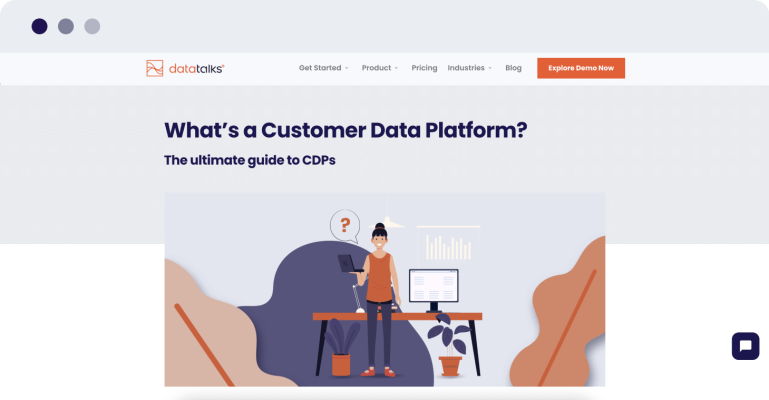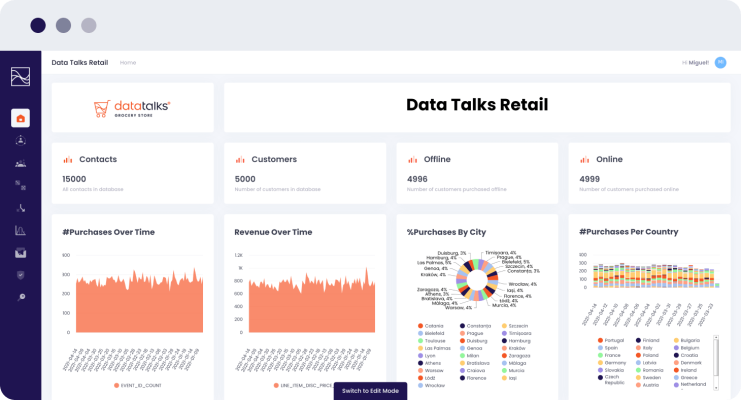“Ecommerce isn’t the cherry on the cake, it’s the new cake”
– Jean Paul Ago, former CEO at L’Oreal (Diginomica, 2016)
Before we dive right in...
Subscribe to our blog today to ensure that you never miss valuable posts such as this one. We are passionate about helping sports organizations deliver a world-class fan experience, because better fan experience means better business. So why not use this opportunity to the fullest?

It’s no secret that the e-commerce and retail industry have experienced a massive boom in the past year, fueled by the Coronavirus. However, it’s important to remember that Covid-19 only sped up a process that was already happening. A process of moving from in-store to online shopping, from queuing in the grocery store to having your food delivered at your front door, from attending live events on spot to streaming your favorite games from the comfort of your own home.
Not surprisingly, with the increase in online consumption came an increase in competition. With more people buying online, new companies emerged and started to rival, in a desperate attempt to get a little piece of the market. As a result, with hyper-competition taking place on a global scale, many actors in the e-commerce and retail sector asked themselves how they can differentiate and stand out from the competition.
So how can you achieve this?
Customer Experience
Creating a customer experience that is beyond expectations is crucial in today’s digital world. It’s the difference between having and not having a successful business, and it’s the key ingredient to becoming the “chosen one” among your competitors. But then, of course, the next question becomes: how do I deliver an exceptional customer experience?
The short answer is:
Customer data
Data is a huge opportunity for many businesses and is especially important for companies in e-commerce and retail. However, many companies today don’t know how to gather their data or extract the business benefits, such as creating loyalty, engagement, and growth. Moreover, relevant and modern marketing requires a unified view of your customer data. It also calls for optimal treatment of each prospect and customer across all channels to bring about the best customer experience possible.
This and more were discussed during our digital event Customer Experience Talks. During this event, thought leaders, industry experts, and digital innovators joined together to share their ideas and insights, and to discuss different questions on how your e-commerce and/or retail business can create an even better customer experience.
So! Let’s dive into the key takeaways from E-commerce and Retail Day.
Key takeaways from E-commerce and Retail Day
Why Your Customer Experience Strategy Needs a CDP
We started the day with Stefan Lavén: CEO at Data Talks, and Erik Brunnegård: Retail & Ecommerce Lead at Data Talks, and their session on the importance of having a CDP and why it’s a key tool in your customer experience strategy.
Stefan begins the session by asking the question:
| “Why is customer experience so important?”
Perhaps a rhetorical question, but maybe a necessary one. To remind ourselves about what a great customer experience looks like and why it’s so important.
Stefan explains that having a great customer experience gets you ahead of the competition. And this is because people are emotional creatures. We make emotional decisions and rationalize them to justify them. And this also applies to the decision-making process of people’s buying behavior online.

“Because we are emotional creatures that make emotional decisions and rationalize them. And Richard Taylor’s research supports this.”
– Stefan Lavén | CEO at Data Talks
So how does this work in practice?
To create a great customer experience, you need to target and communicate messages that are both relevant and engaging to a particular customer. The challenge is then to reach your prospects and customers through all the noise and distractions they encounter online. And to accomplish this, you need customer data.

“It’s important to have one platform that can handle targeted omnichannel communication. To be information-driven, we need to unify the data to leverage it.”
– Erik Brunnegård | Retail and E-commerce Lead at Data Talks
At this stage, you might be asking how exactly you can unify that mountain of data you have compiled over the years. Or perhaps you are just starting out and wondering how you can best collect and structure your data. Well, -surprise surprise-, this is where a Customer Data Platform (CDP) comes into the picture.
A CDP allows you to collect, analyze, and act on your data, to deliver tailored and engaging content to your target audience. An important first step when choosing a CDP is making sure it is a certified CDP. Once you have established that it is, you have two options: buying from a larger and more famous corporation or investing in a “best-of-breed” software.
But wait, what exactly is a best-of-breed product?
Simply put, and as the name entails, it’s the best product on the market for your particular need. Even if the offering happens to be from a smaller vendor, you are not dependent on one vendor for innovation power. In other words, you don’t put all your eggs in one basket and instead diversify the risk. In fact, over 67 percent of companies choose a best-of-breed strategy over investing in a larger vendor.

To get into the details,
take a look at our >> CDP Guide.
Using Customer Insights Systematically to Grow Your Retail & E-commerce Business
Up next, we invited Sven Törnkvist: Head of Digital Business Development at EQT up on stage to talk about using customer insights systematically, and how to use them to grow your retail and e-commerce business.
Sven starts by telling that, during the past 30 years, customers have acquired “superpowers”. Superpowers that have come about thanks to the digital transformation, with the internet playing a major role in giving people access to an abundance of information. Now customers can do their own due diligence about products and services, feeding the already well-known motto “the customer is always right”.
So, how do you succeed in a customer-centric world?
Once again, it’s all about offering an exceptional customer experience, and this requires keeping up to date with the change in consumer behavior.

“Some companies – like Amazon, Netflix, and Spotify – not only offer an exceptional customer experience, but also shape customer expectations for everyone else in the industry.”
– Sven Törnkvist | Head of Digital Business Development at EQT
However, for savvy players there is still a massive opportunity that can be leveraged in the change in consumer behavior:
For starters
Begin with actually using the technology, not just buying it, and focus on mining data for actionable customer insights.
Contextual data
Use contextual data to beat competitors on advertising bidding.
Real-time
Conduct real-time, data-driven responses to target customers with relevant messages at the right time.
Test, learn and iterate
This helps you become more successful in your overall digital transformation journey.
The value of digital maturity
Being digitally mature will allow you to grow faster and be much more efficient in the long run.
Start building your digital transformation at your sales and marketing department.
By understanding the relevance of data and creating the right strategy, you can leverage the change in consumer behavior, and in turn, create an unforgettable customer experience.
Preparing for Post Covid: Working With a Data-Driven Marketing Approach to Fuel Growth
In this session, we invited Åsa Blomberg: Marketing and Communications Manager at Myrorna, and Johan Holmström: Head of Marketing at Mediatool for a discussion with our Retail and E-commerce Vertical Lead Erik Brunnegård, on working with a data-driven marketing approach and how to use it to fuel growth.
Åsa begins by telling how Covid-19 has forced actors in the retail and e-commerce industry to take a huge leap forward in their digitalization processes. At Myrorna, they had to quickly establish a digital presence in both e-commerce and their marketing, as well as learning even more about their customers.
Johan adds that new audiences have also been pushed online and that several of these audiences have high expectations of digital vendors and the overall customer experience. And the customer experience becomes equally as important when customers do in-store shopping.

“I think the online and offline will merge over time. I also think that what will be missing online is the service level not being the same, so service in the physical stores will become even more important.”
– Åsa Blomberg | Marketing and Communications Manager at Myrorna
She continues to explain that it’s hard for sales to give everyone a good customer experience since visitors have different needs and expectations. For this reason, it’s important to know your customers before you even serve them. And to achieve this, you need data.
So the next step becomes looking into the tools and technology your company is currently using, and whether they do help you deliver an excellent customer experience. Having the right tools allows you to collect both online and offline data to create a unified view of your customers, which in turn lets you deliver relevant messages to your audiences in all touchpoints.
The challenge then becomes knowing where to start and creating a scope of what data you would like to collect. With the right technology, for example, a Customer Data Platform (CDP), you can facilitate the data-collection process, so you can instead focus on analyzing the relevant data points and acting on them.
Digital Expert
In this session, Pantelis Parastatidis: Chief Product Officer at Data Talks, gave us a tour of the Data Talks CDP and explained: how to connect your data sources into Data Talks CDP, how to monitor your KPIs & build your dashboards, how to segment your database and how to target your audience using personalized emails.

Want to see for yourself? Take a tour of our CDP Demo for Retail and E-commerce businesses here.
The Importance of Customer Experience in the Convenience Economy
Up next, we welcomed Thomas Jensen: Managing Director of BCG Sweden and Global Retail Expert, to the stage for his session on the importance of customer experience in the convenience economy.
Thomas started by telling that the Swedish retail landscape will change significantly towards the year 2025, and that Covid-19 was just a push in the same direction: from a Convenience Economy towards an Experience Economy.
| “Most segments in Sweden are currently in the Convenience Economy, moving towards an Experience Economy“. – Thomas Jensen | Managing Director of BCG Sweden and Global Retail Expert
According to Thomas, three drivers are accelerating this transition in Sweden:

Covid-19
Has led to a rise in e-commerce demand.

Shifted expectations
Shifted expectations in supply and delivery, driven by Amazon - who today generates the highest amount of online traffic in Sweden to their Swedish website.

Online acceleration
Acceleration of online due to Ica's Ocado investment.
So, who wins and when?
As you might have guessed, it’s companies who deliver excellent customer experience. And this means ensuring the customer experience strategy is adapted throughout all steps of the customer journey, which are: orientation, selection, transaction, delivery, and customer care. You need to find out how you will design this experience, and whether you will focus on certain areas of the journey more.

“Retailers need to embrace the new technology and merge it with their expertise, to succeed in an experience-driven market.”
– Thomas Jensen | Managing Director of BCG Sweden and Global Retail Expert
Having a customer journey design in place will also help you be ready for the future rise of experiential retail, where physical stores will play an important role in delivering a differentiated customer experience. To achieve this, you need to unify all the data scattered across your value chain, analyze it, and use the findings to deliver a tailored customer experience.
Finally, to adapt to the digital transformation, companies also need to remodel their company culture. You need to integrate the digital changes into the company culture and embrace testing and learning from your mistakes – to dare to fail and learn from it.
Business Growth Through Hyper-Personalization
Then it was time for our final session, held by Patrik Olsson: CEO at Cyberphoto, where he would talk about how to create business growth through hyper-personalization.
In his session, Patrik emphasized the importance of delivering the best possible customer experience, and that the key to standing out from the crowd, no matter what market your business is in, is exceeding the expectations of your customers.

“Exceeding expectations and being the best in taking care of your customers, it’s easy to say but not as easy to live by. Today, it’s the small things that make the difference.”
– Patrik Olsson | CEO at Cyberphoto
It’s therefore important to implement this mindset on all levels of your organization and embrace personal responsibility, to create and enforce a multi-level marketing strategy that has been around long before the digital movement. This marketing strategy is, simply, word-of-mouth.
| “Thanks to tools such as Customer Data Platforms and Marketing Automation Systems, we can make our system show only what the customer is interested in, based on the data we have received about the customers.” – Patrik Olsson
But to leverage this strategy, you need to have a data-driven approach in place. Without data, you can’t pinpoint your customers’ wants and needs. As Patrik mentioned, having the right technology in place will let you target prospects and customers with relevant and engaging content, which lets you bring about an unforgettable customer experience.
Final Thoughts
The digital transformation has indeed brought about some major changes and challenges for retail and e-commerce businesses. But for savvy players with the right tools and a data-driven approach, this change is an opportunity. Because, at the end of the day, it’s all about the customer experience. And if you enforce this mindset throughout your whole organization, the change in consumer behavior will indeed become your oyster.